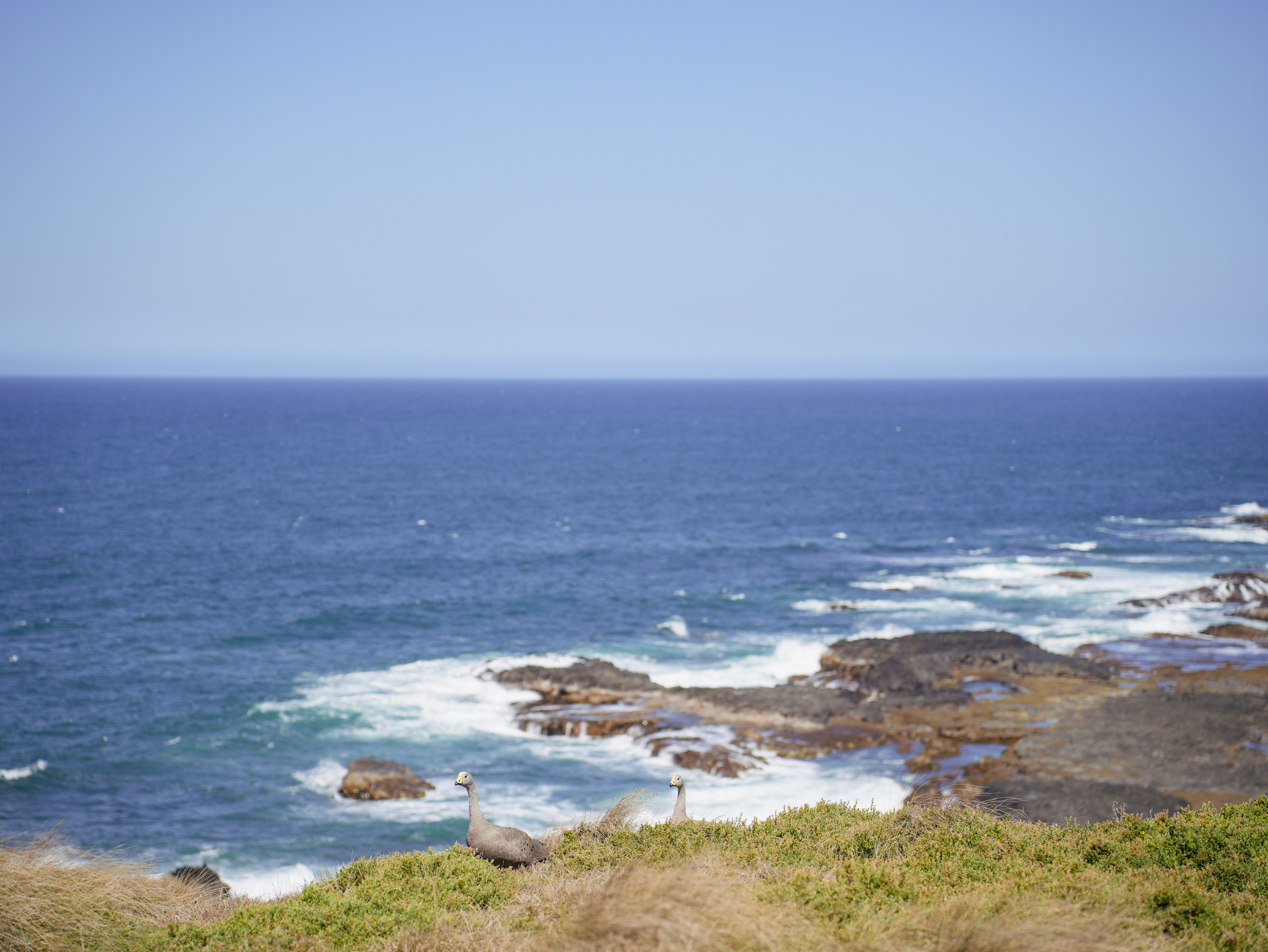
Cape barren geese on the Summerlands Peninsula at Phillip Island (Millowl).
Photo: Phillip Island Nature Parks.
What is the purpose of the Phillip Island (Millowl) Wildlife Plan?
Phillip Island’s unique coastal and rural landscapes support a variety of native wildlife, agricultural activities, and tourism. However, there are challenges related to wildlife conservation, agriculture, cultural values, infrastructure, safety, and animal welfare.
The goal of the plan is to sustain a balanced population of native wildlife while allowing for continued environmental, social, cultural, economic, and farming activities. This will be achieved through community engagement, evidence-based decision-making, and coordinated strategies, including education, research, and sustainable wildlife management.
The plan also aims to support agricultural communities and complement existing biodiversity efforts, with a focus on balancing wildlife and community needs over the next 5 years.
How was the Phillip Island (Millowl) Wildlife Plan developed?
The Plan was developed collaboratively by a steering committee that included representatives from the Department of Energy, Environment and Climate Action (DEECA), Bass Coast Shire Council (BCSC), Phillip Island Nature Parks (Nature Parks), and landowners. The committee worked closely with the community and the Bunurong Land Council Aboriginal Corporation (BLCAC) to incorporate their views and aspirations.
Community input was gathered through meetings, workshops, and public feedback on the draft Plan via the Engage Victoria website and online sessions. Various communication channels, such as emails, social media, and the Engage Victoria page, were used to keep the community informed throughout the Plan's development.
What are the key wildlife species of the Phillip Island (Millowl) Wildlife Plan?
Three key native wildlife species; Cape Barren Geese, Swamp Wallabies and Common Brushtail Possums are the current focus of this plan due to increases in these populations and concerns raised by the community regarding their impacts on agriculture, environment, public safety, amenity and animal welfare.
Any emerging wildlife issues will be captured through the monitoring and review processes of the Plan to ensure they are addressed.
Why does the Plan not include threatened species and pest animals?
The Plan does not address specific actions for the recovery and management of threatened species on Phillip Island, such as Hooded Plovers, or the control of non-native and pest species like rabbits however, the Plan does acknowledge and support existing programs and conservation efforts, such as cat regulations.
Pest species such as rabbits, foxes and cats are not included in the Plan as the focus is on native wildlife and issues with pest species are addressed through existing works delivered through the Integrated Pest Animal Strategies and work undertaken through Nature Parks and Landcare.
How are the actions in the Phillip Island (Millowl) Wildlife Plan different to what is happening now?
The Plan presents a more proactive, coordinated and place-based approach that balances the needs of wildlife and the community. The actions in the plan are strategic and focused on delivering long-term outcomes and enabling better collaboration across key agencies and groups and the community.
The Plan promotes positive attitudes towards wildlife and nature by informing, engaging and inspiring participation from the community to contribute to healthy and sustainable wildlife populations on Phillip Island.
A key focus of the Plan is to continue to build knowledge and understanding of key wildlife populations and their impacts to inform evidence-based decision making to ensure the effective management of wildlife on Phillip Island (Millowl).
What management methods will be used and what will happen to the wildlife?
The Plan focuses on exploring innovative management options to improve animal welfare outcomes. This includes trials for active wildlife management, such as creating alternative freshwater sources for wildlife to reduce road collisions, controlling Cape Barren Goose populations through egg removal and decoy crops, and using repellents to protect revegetation areas. Current wildlife management methods are often reactive and ineffective, with lethal control only available as a last option through the Authority to Control Wildlife (ATCW) system.
The Plan also supports local landholders in finding more effective ways to manage wildlife impacts and encourages them to adapt and diversify farming practices for sustainability and wildlife conservation.
What is an Authority to Control Wildlife (ATCW)?
Under the Wildlife Act 1975, it is illegal for anyone to control (take or destroy) wildlife (including eggs) without an authorisation to take or destroy wildlife known as an Authority to Control Wildlife (ATCW). An ATCW allows wildlife to be controlled in certain circumstances, where the wildlife is posing a risk to human health or safety, damaging property, crops or pasture or impacting on biodiversity. Wherever feasible and practical, DEECA encourages the use of non-lethal means of controlling wildlife.
Who manages wildlife on Phillip Island (Millowl)?
The conservation and management of wildlife is a shared responsibility by all members of the Victorian community. Achieving the best for our wildlife, the environment, public amenity, safety and industry (tourism and agriculture) requires communities, government and industries to work together and share the responsibility.
All native wildlife is protected in Victoria and it is an offence to kill, take, control or harm wildlife under the Wildlife Act 1975. DEECA regulates protection and use of wildlife consistent with the Wildlife Act in Victoria, including on Phillip Island (Millowl).
What evidence is guiding the actions of the Phillip Island (Millowl) Wildlife Plan?
The development of the Plan has been guided by existing and ongoing research undertaken by independent universities and agencies such as the Nature Parks and BCSC. This includes research on the populations of key species and their impacts. The key findings of this work have been included in the case studies and appendices in the plan.
A key focus of the plan is to continue to build knowledge and understanding of key wildlife populations and their impacts to inform evidence-based decision making. The research and development tasks will be delivered, reviewed and communicated effectively to ensure the information is credible, reliable and transparent.
Page last updated: 14/07/25